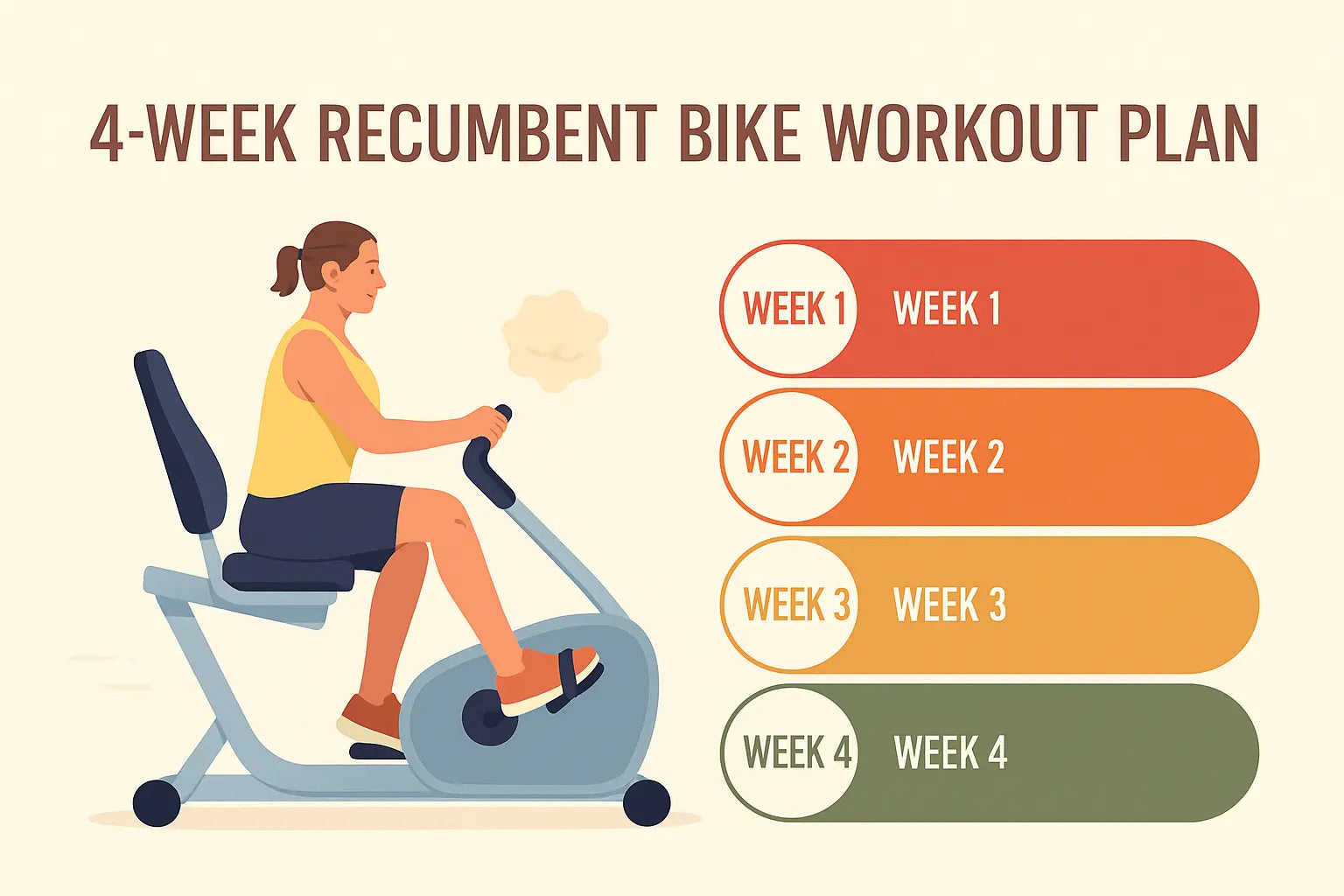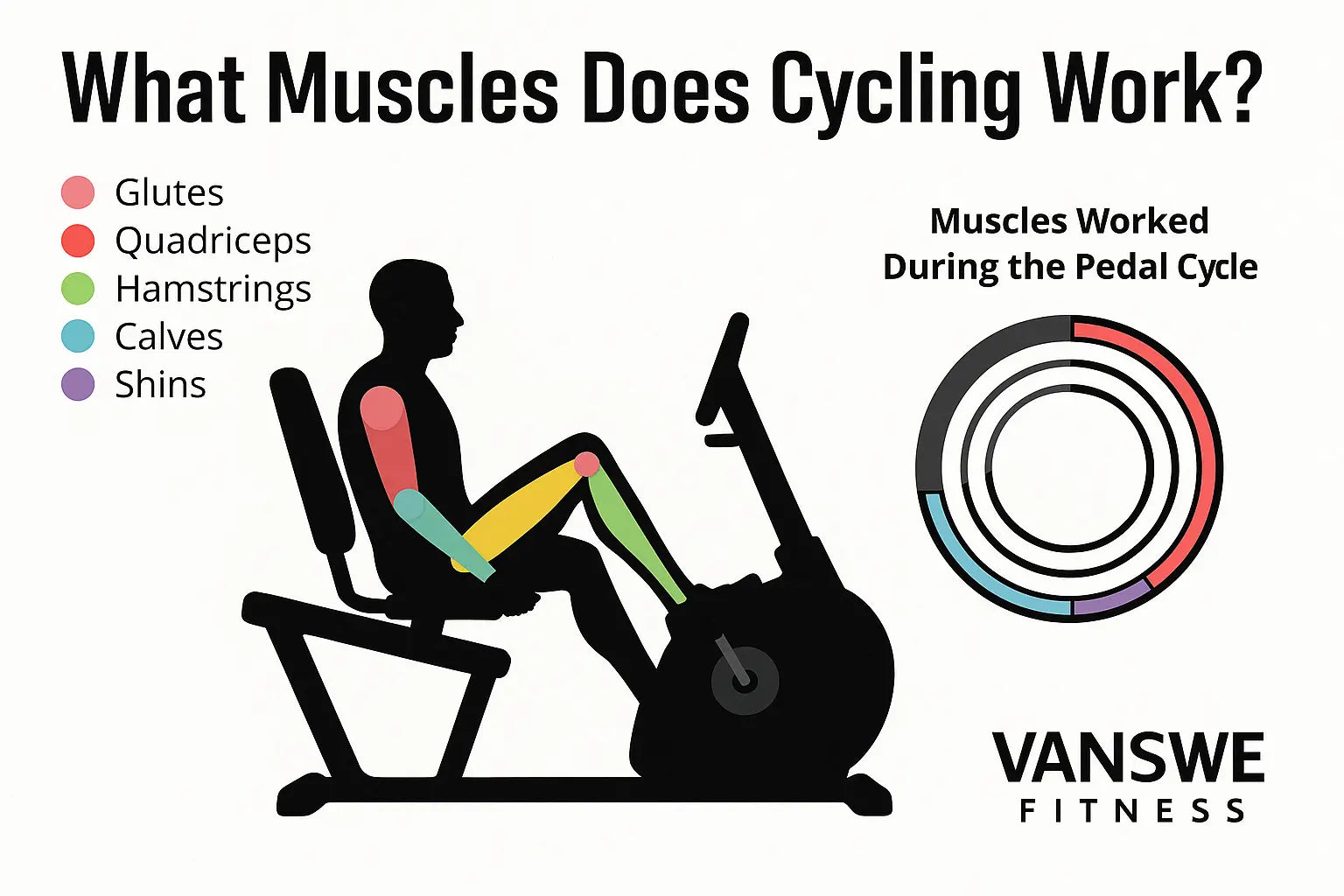Recumbent Bike for Weight Loss: Why You're Not Dropping Pounds

Have you ever wondered why some people eat more and exercise less than you—yet stay slimmer? Have you been riding your recumbent bike regularly but still struggling to lose weight?
The truth is, it only takes FIVE simple steps to turn things around and start seeing real weight loss results with your recumbent bike.
Here’s the 5-step system that helps you turn your recumbent bike workouts into fat-burning success.
- Calculate Your Weight Loss Timeline
- Calculate Your Daily Calorie Intake
- Calculate Your Daily Calorie Expenditure
- Calculate Your Calorie Deficit
- Calculate Recumbent Bike Workout Duration
Step 1 - Calculate Your Weight Loss Timeline
According a reseach from the Centers for Disease Control and Prevention (CDC)[1], losing 1–2 pounds per week is a safe and effective weight loss rate.
1-2 pounds per week is a healthy but sustainable range. At this rate, you don’t need to worry about rebound in weight gain. You just need to make a balanced diet and a middle level exercise.
Using myself as an example. Assuming my current weight is 205 lbs, and my ideal weight is 165 lbs, and I choose a safer approach to weight loss (1 pound per week), then my ideal weight loss timeframe would be 205 - 165 = 40 weeks.
How to Calculate Your Ideal Weight (IBW)
You can calculate your Ideal Body Weight (IBW) using formulas such as the Devine, Robinson, and Miller equations, or by referencing the healthy BMI range. However, the calculations can be a bit complex. To make it easier, we’ve prepared a height vs. ideal weight chart based on typical ranges for U.S. adults.
| Height | Male Ideal Body Weight | Female Ideal Body Weight |
|---|---|---|
| 4' 6" | 63 - 77 lbs. | 63 - 77 lbs. |
| 4' 7" | 68 - 84 lbs. | 68 - 83 lbs. |
| 4' 8" | 74 - 90 lbs. | 72 - 88 lbs. |
| 4' 9" | 79 - 97 lbs. | 77 - 94 lbs. |
| 4' 10" | 85 - 103 lbs. | 81 - 99 lbs. |
| 4' 11" | 90 - 110 lbs. | 86 - 105 lbs. |
| 5' 0" | 95 - 117 lbs. | 90 - 110 lbs. |
| 5' 1" | 101 - 123 lbs. | 95 - 116 lbs. |
| 5' 2" | 106 - 130 lbs. | 99 - 121 lbs. |
| 5' 3" | 112 - 136 lbs. | 104 - 127 lbs. |
| 5' 4" | 117 - 143 lbs. | 108 - 132 lbs. |
| 5' 5" | 122 - 150 lbs. | 113 - 138 lbs. |
| 5' 6" | 128 - 156 lbs. | 117 - 143 lbs. |
| 5' 7" | 133 - 163 lbs. | 122 - 149 lbs. |
| 5' 8" | 139 - 169 lbs. | 126 - 154 lbs. |
| 5' 9" | 144 - 176 lbs. | 131 - 160 lbs. |
| 5' 10" | 149 - 183 lbs. | 135 - 165 lbs. |
| 5' 11" | 155 - 189 lbs. | 140 - 171 lbs. |
| 6' 0" | 160 - 196 lbs. | 144 - 176 lbs. |
| 6' 1" | 166 - 202 lbs. | 149 - 182 lbs. |
| 6' 2" | 171 - 209 lbs. | 153 - 187 lbs. |
| 6' 3" | 176 - 216 lbs. | 158 - 193 lbs. |
| 6' 4" | 182 - 222 lbs. | 162 - 198 lbs. |
| 6' 5" | 187 - 229 lbs. | 167 - 204 lbs. |
| 6' 6" | 193 - 235 lbs. | 171 - 209 lbs. |
| 6' 7" | 198 - 242 lbs. | 176 - 215 lbs. |
| 6' 8" | 203 - 249 lbs. | 180 - 220 lbs. |
| 6' 9" | 209 - 255 lbs. | 185 - 226 lbs. |
| 6' 10" | 214 - 262 lbs. | 189 - 231 lbs. |
| 6' 11" | 220 - 268 lbs. | 194 - 237 lbs. |
| 7' 0" | 225 - 275 lbs. | 198 - 242 lbs. |
Tips:The original ideal body weight chart was developed by MET Life, 1943.
Step 2 - Calculate Your Daily Calorie Intake
Many people's first instinct is to eat as little as possible. But this is actually one of the main reasons why people fail to stick with their weight loss plans. We must understand the key concept of BMR。
What's BMR and How to Calculate
BMR is the least number of calories your body requires to perform basic life-sustaining functions, such as heartbeat, respiration, and temperature regulation when you are at complete rest with no physical activity (For example, you lie on your bed and watch YouTube all day.)
In the 1990s, the nutritionists Mark D. Mifflin and Mary L. St Jeor created the Mifflin-St Jeor Equation [2] by using larger sample sizes and more modern experimental data.
The following equation provides a more precise way to calculate your BMR in present-day society:
Mifflin-St Jeor Equation
For Men:
BMR=66+(6.23×weight in pounds)+(12.7×height in inches)−(6.8×age in years)
For Women:
BMR = 655 + (4.35 × weight in pounds) + (4.7 × height in inches) − (4.7 × age in years)
Using myself as an example, I am 39, weigh 165 lbs, and am 6 feet 1 inch (73 inches) tall. My BMR is:
66+(6.23× 165 pounds)+(12.7×73 inches)−(6.8×39 in years) = 1755 kcal
Here is the most important thing: our daily calorie intake should never fall below our BMR.
If you consistently consume fewer calories than your BMR, it can lead to the following consequences:
Physical Effects
-
Metabolic Adaptation
Your body enters "energy-saving mode," reducing calorie expenditure. As your BMR drops, fat loss becomes harder—this is known as "metabolic adaptation" or "starvation mode." -
Muscle Loss
When calorie intake is insufficient, the body may break down muscle tissue for energy, especially if protein intake and resistance training are lacking. -
Hormonal Imbalance
- Women: Irregular periods or even amenorrhea (known as "functional hypothalamic amenorrhea")
- Men: Decreased testosterone levels
- Both: Weakened thyroid function, elevated cortisol, and more
-
Weakened Immunity
Inadequate nutrients make it harder for the body to repair tissues and fight off pathogens, increasing the risk of illness.
Psychological Effects
-
Lack of Focus and Mood Swings
When the brain lacks glucose, symptoms like irritability, low mood, and poor concentration may appear. -
Increased Binge Eating Tendencies
A prolonged low-calorie diet can trigger binge eating episodes, leading to a vicious cycle of restriction and overeating.
Other Side Effects
- Hair loss, dry skin, and brittle nails
- Chronic fatigue and increased sensitivity to cold
- Decreased athletic performance and slower recovery
These effects can make it difficult to sustain long-term weight loss. No matter how you plan your diet, your daily calorie intake should never fall below your BMR.
With a BMR of 1755 kcal and limited time for exercise, I would decided to follow a stricter dietary plan and keep my daily calorie intake at 1755 kcal.
Tips:
How to estimate daily calorie intake? Why am I always so hungry on my diet plan?
See the FAQ section at the bottom of this article.
Step 3 - Calculate Your Daily Calorie Expenditure
Now let's calculate how many calories your body burns daily without any additional recumbent bike exercise. To do this, we need to understand the key concept: TDEE (Total Daily Energy Expenditure).
How to Calculate Your TDEE
TDEE stands for Total Daily Energy Expenditure [3] — it’s the total number of calories your body burns in a day through all activities.
We get our BMR in Step 2, now we only need to multiply it by an activity factor to find out our TDEE:
TDEE = BMR × Activity Factor
To figure out your TDEE, you take your BMR and multiply it by an "activity factor" — based on how much you move around during a typical week.
Here's how to pick the right activity factor:
-
1.200 = Sedentary
You barely move during the day. You spend most of your time sitting — maybe at a desk, watching TV, or reading. -
1.375 = Lightly Active
You get some exercise 1–3 times a week, like going for a walk, doing some light stretching, or an occasional workout — but there are definitely days you just stay on the couch. -
1.550 = Moderately Active
You’re more consistent — exercising or playing a sport 3–5 days a week. You might lift weights a few times and do cardio on other days. -
1.725 = Very Active
You’re serious about fitness. You move your body almost every day, whether it’s gym workouts, classes, biking, or other activities. -
1.900 = Extra Active
You either have a very physically demanding job (like construction work) or you train like a pro athlete.
For example, I basically sit in front of computer all day, so my activity factor is 1.200. Then my TDEE
1755×1.2=2106 kcal
Step 4 - Calculate Your Calorie Deficit
A calorie deficit happens when you consume fewer calories than your body needs to maintain its current weight.
In simple terms:
Calories in < Calories out = Weight loss
Remember my goal was to lose 1 pound of fat per week? So how many calories does 1 pound of fat equal?
According to data from Mayo Clinic [4], one pound of body fat is roughly equivalent to 3,500 kilocalories (kcal).
So, if I want to lose 1 pound per week, then the difference between the calories my body burns and the calories I consume through food must be at least 3,500 kcal per week.
3,500 kcal ÷ 7 days = 500 kcal per day
This means I need a daily calorie deficit of 500 kcal. If you aim to lose 2 pounds per week, then your daily calorie deficit should be 1,000 kcal.
Using myself as an example:
In Step 2, I set my daily calorie intake to be 1,755 kcal.
In Step 3, I calculated my TDEE to be 2,106 kcal.
Without doing any exercise, my natural daily calorie deficit is:
2,106 kcal - 1,755 kcal = 351 kcal
But my target is a daily calorie deficit of 500 kcal.
500 kcal - 351 kcal = 149 kcal
So how do I burn the remaining 149 kcal? That's right — through recumbent bike exercise!
Step 5 - Calculate Recumbent Bike Workout Duration
You can estimate your workout duration using two formulas: the ACE heart rate-based formula and a MET-based estimation.
ACE Heart Rate-Based Formula
The American Council on Exercise (ACE) provides a calorie burn formula using heart rate, weight, and workout duration:
For male:
Calories/min = (-55.0969 + (0.6309 × HR) + (0.1988 × weight in kg) + (0.2017 × age)) / 4.184
For female:
Calories/min = (-20.4022 + (0.4472 × HR) - (0.1263 × weight in kg) + (0.074 × age)) / 4.184
Multiply by the total number of minutes ridden to get your estimate.
MET-Based Estimation
METs (Metabolic Equivalent of Task) represent the energy cost of physical activities — the higher the MET, the more calories you burn.
- Light Effort: ~3.5 METs
- Moderate effort: ~5.5 METs
- Vigorous effort: ~7.5 METs
We recommend using the ACE formula, as it fully takes individual differences into account. However, since the calculation can be a bit complex, we suggest visiting our Recumbent Bike Calories Burned Calculator. On this page, you'll find an easy-to-use online tool for estimating calorie burn, along with a guide to help you estimate your heart rate zone based on how you feels in workouts.
FAQs
How to estimate daily calorie intake?
The most important thing is to buy a kitchen scale and weigh everything you eat. And I mean everything—a spoonful of sugar, a packet of sauce, and every little snacks.
You might be surprised by how many calories you consume daily without noticing it.
You MUST enter all food data into a calories burned tracking app, like MyFitnessPal or Cronometer.
Maintain this habit for at least six months until you can roughly approximate how many calories are in everything you eat.
Why am I always so hungry on my diet plan?
If your BMI is over 35, it's unlikely that you can manage your diet on your own. Please seek help from a doctor.
If your BMI is below 35 but you still struggle to stick to your diet plan, it might be because you're choosing the wrong types of food.
To explain this, I researched USDA FoodData Central [5] and compared a few common foods based on their calories. It's shock to see how much they differ in one glance - Two chicken breasts contain roughly the same calories as one palm-sized piece of chocolate.
| Food | Chocolate | Boiled Broccoli | Chicken Breast | White Rice |
|---|---|---|---|---|
| Weight | 3.5 oz | 52.9 oz | 11.8 oz | 14.9 oz |
| Volume | a few pieces | 1 pot | 2 plates | 1 bowl |
| Calories | ~550 kcal | ~550 kcal | ~550 kcal | ~550 kcal |
I mean, don't get me wrong—you could definitely eat a dozen chocolates without a problem, but eating two full plates of chicken breast in one sitting would be quite something.
Chocolate has several times the calories of chicken breast, it still makes you feel hungry much much sooner.
Conclusion
A recumbent bike offers an effective, low-impact solution for sustainable weight loss. According to the American Council on Exercise (ACE) and other health organizations, consistent aerobic exercise — combined with a moderate calorie deficit — is key to long-term fat loss.
By following a structured 5-step system—setting a realistic weight goal, calculating your calorie needs, creating a daily deficit, and tailoring your bike workouts—you can achieve steady weight loss results.
Commit to the plan, monitor your progress, and adjust your calorie intake and workout intensity as needed. With patience and consistency, your recumbent bike can become a powerful tool for achieving and maintaining your ideal weight.
References
- Centers for Disease Control and Prevention (CDC). Losing weight. [Internet]. Atlanta (GA): Centers for Disease Control and Prevention; [updated 2022 Jan 10; cited 2025 Jan 24].
- Mifflin, M. D., St Jeor, S. T., Hill, L. A., Scott, B. J., Daugherty, S. A., & Koh, Y. O. (1990). A new predictive equation for resting energy expenditure in healthy individuals. The American journal of clinical nutrition, 51(2), 241–247. https://doi.org/10.1093/ajcn/51.2.241
- Wikipedia contributors. (2025, April 4). Energy expenditure. In Wikipedia. https://en.wikipedia.org/wiki/Energy_expenditure
- Mayo Clinic Staff. (n.d.). Calories: How to know if you're burning enough. Mayo Clinic. https://www.mayoclinic.org/healthy-lifestyle/weight-loss/in-depth/calories/art-20048065
- United States Department of Agriculture (USDA). FoodData Central. [Internet]. Washington (DC): USDA; [cited 2025 Jan 24].
Latest Articles






